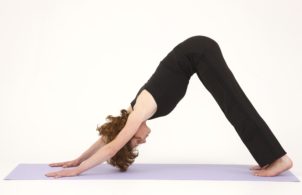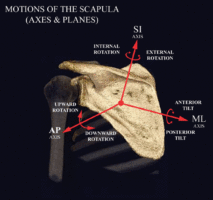Beware Putting Those Shoulder Blades
in Your Back Pocket!
 If you’ve ever taken a Pilates class, or a dance class, or a yoga class, or any movement class that involves a postural component to the activity, you’ve probably heard this cue, or something like it, for movement & support in the arms & shoulders:
If you’ve ever taken a Pilates class, or a dance class, or a yoga class, or any movement class that involves a postural component to the activity, you’ve probably heard this cue, or something like it, for movement & support in the arms & shoulders:
“Let your shoulder blades slide down your back, as if you could slip them into your back pockets.”
As a young movement teacher, I learned this cue well. I heard it around me so often that I took it quite to heart. I used this image a lot. For people who had rounded, elevated shoulders, it seemed to my young and inexperienced eye, to get great results! When people dropped their shoulder blades down their backs, they seemed to gain more stability and control in their arm movements; they seemed to be able to handle heavier loads with less effort; it seemed to promote a generally more upright spine. I adopted this cue for my own movement as well. I felt like it made me STRONG. But then I noticed that it wasn’t all good for me or for anyone else.
The Problem with Shoulder Blades and Back Pockets
After a while, I realized that this common cue can create some seriously undesirable conditions in the body too. Many people, although feeling stronger, were actually experiencing negative changes in the mobility of their arms and upper bodies. Some were noticing changes in their breath capacity. It happened to me too. Activities with my arms overhead became more challenging, disrupting my thorax and my spine as I moved. My ribs became more and more compressed, and spinal extension became more challenging. Hmmm… what was I missing?
With a little more research, education and observation, I realized that this cue often created conditions where the shoulder blades themselves became locked onto the thorax in a way that made free and full range of motion nearly impossible!
About The Shoulder Girdle
The shoulder girdle is a wonder of function and mobility. Did you know that the only bony attachment of the shoulder girdle to the main body of your skeleton is at the breastbone, via your collarbone? The rest of the shoulder girdle connects to the thorax via soft tissue – muscles and ligaments. This incredible feature allows the shoulders and arms to have an astonishing range of motion. But it also means that they are especially susceptible to dysfunction through imbalance of the muscles. When one muscle or motion is over-emphasized, there could be serious implications for mobility, and it could make you more susceptible to injury too.
 In simple terms, the shoulder blades have the ability to slide in toward the spine (retraction); to slide away from the spine (protraction); slide straight up (elevation); or straight down (depression); to tilt forward or tilt backward and to rotate around a somewhat central axis. All of these motions are necessary for good shoulder function.
In simple terms, the shoulder blades have the ability to slide in toward the spine (retraction); to slide away from the spine (protraction); slide straight up (elevation); or straight down (depression); to tilt forward or tilt backward and to rotate around a somewhat central axis. All of these motions are necessary for good shoulder function.
When we “slide our shoulders into our back pockets,” we can potentially create too much depression in the shoulder girdle. If the latissimus dorsi muscle gets too eagerly engaged in this process, the shoulder blades tilt forward, hugging the top of the back. The upper arms roll forward, making it hard to maintain a good connection to the back of the rotator cuff and spinal extensors. The shoulder blades can get literally “locked,” via overactive muscles, to the thorax, effectively rendering them unable to tilt backward and rotate as they need to when the arms are lifted overhead. (Visit our Facebook Page for this quick “Tuesday Movement Tips” video on posture and the shoulder girdle. Get some easy tips on how to open things up!)
The result?
When the scapula are “locked and loaded” the result is often more bulk in the muscles at the front of the chest and arms and on top of the shoulder. Compression and dysfunction may show up in the rib cage, accompanied by weakness in the upper spine, and rotator cuff. It may become difficult to extend the upper spine and raise the arms overhead. Heck, it can also create breath pattern dysfunction by creating challenges for free movement in the rib cage. (For more on the rib cage and thoracic mobility, check out “Un-cage Your Ribs for Better Mobility’)
So what now?
It’s time for a different picture. The shoulder blades need to be able to connect to the spine; so yes – a little drop may be necessary. But the shoulder blades need to be able to float too. If you drop the shoulder blades strongly, and feel lots of muscle activity in your armpits; then you may be overloading the wrong stuff. Instead, imagine a lightness in the motion of your shoulder girdle – even when lifting heavy loads. Allow the bottom angle of the shoulder blade to stream down the back gently, just enough so that your shoulders are not lifted up around your ears. Then imagine a little helium balloon in the back of each armpit, supporting the weight of the shoulder girdle. You want to be able to feel space between the back of the armpit and the front of the shoulder blade. Allow them to tip gently backward and feel the easy rotation of those shoulder blades, and the outward rotation of the arm in the shoulder socket as you raise your arms forward and up (or press back into that downward dog).

Pay attention to how your shoulder girdle is moving relative to your spine and thorax. With a little conscious care and patterning, you’ll find that your shoulders not only move better, they allow more freedom in the thorax and spine as well, and fewer “issues” in your neck!
And movement teachers – remember that a cue that works in your body may not work for others. Always watch carefully for the EFFECTS of your cueing, on the whole body. Because in this, as in many things, one size does NOT fit all.
What are some of your favourite cues for the shoulders, arms and upper body? Are there ones that have worked especially well for you? Or especially bad ones? I’d love to hear some of your experiences – leave a comment below!
